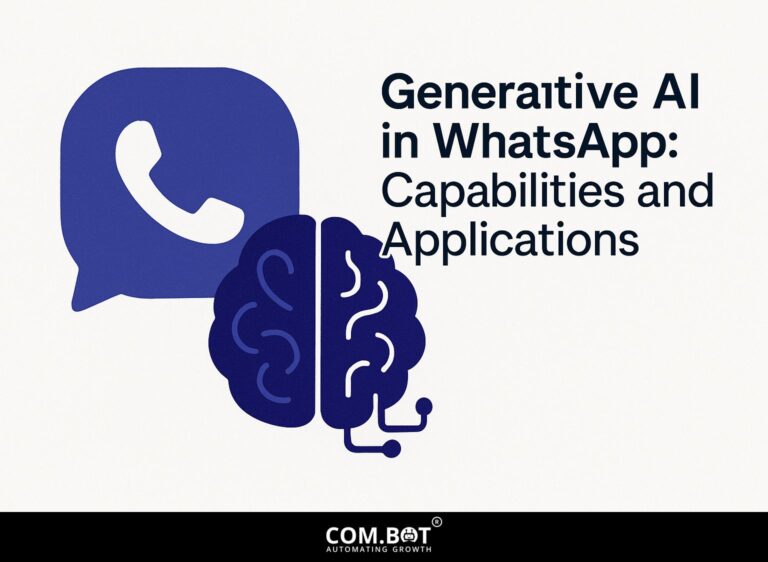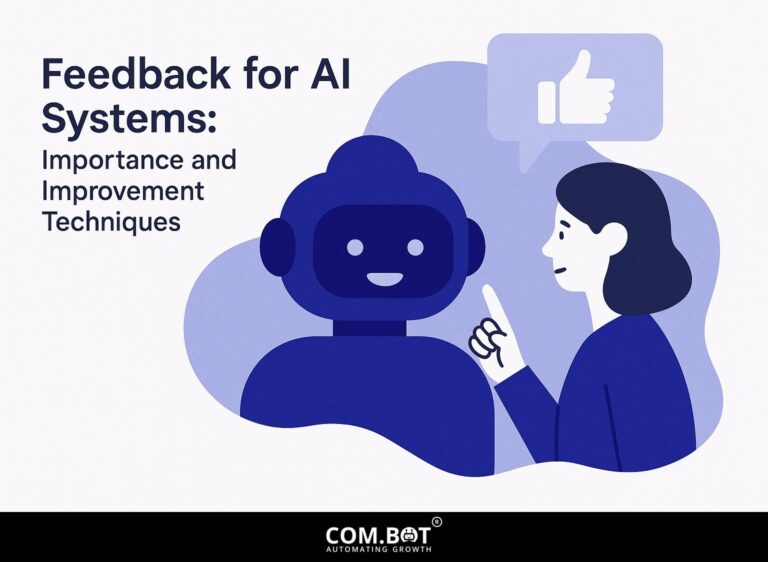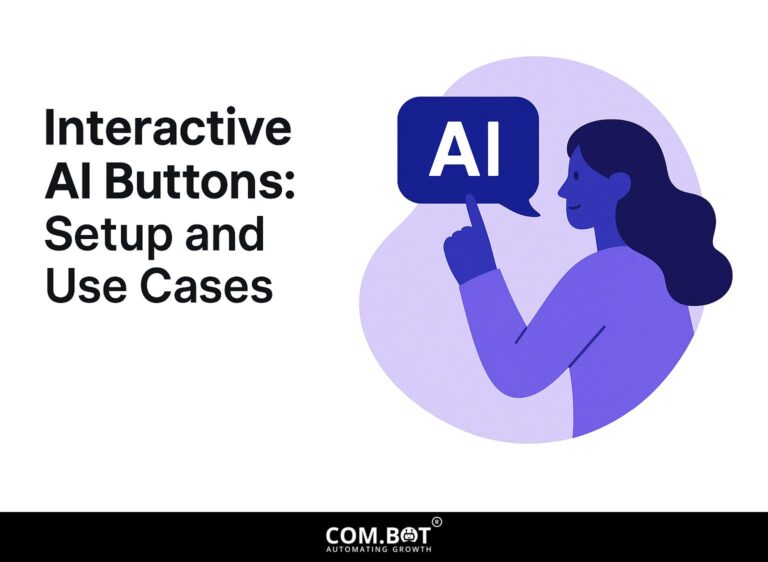Feedback for AI Systems: Importance and Improvement Techniques
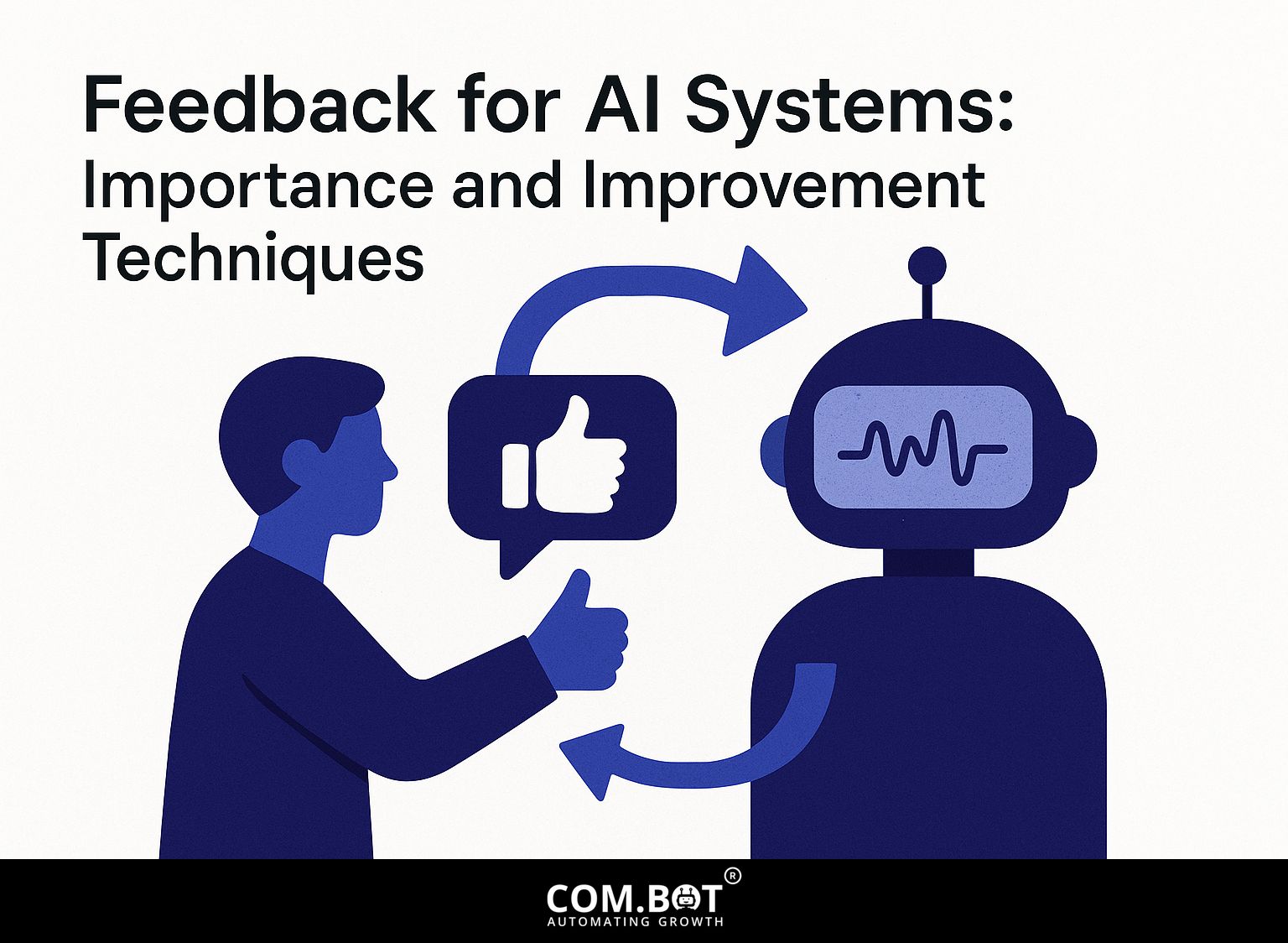
As artificial intelligence quickly changes, human feedback is very important for improving AI systems. Developers can improve how their tools work, such as Label Studio, by using methods like reinforcement learning and machine learning. This article looks at why feedback matters in improving AI systems and offers practical methods for ongoing progress. These methods help AI systems work well and gain user confidence.
Key Takeaways:
- 1 Importance of Feedback in AI
- 2 Types of Feedback Mechanisms
- 3 AI Feedback Mechanism Statistics
- 4 Techniques for Gathering Feedback
- 5 Analyzing Feedback Data
- 6 Implementing Feedback for Improvement
- 7 Challenges in Feedback Integration
- 8 Upcoming Trends in AI Feedback Systems
- 9 Frequently Asked Questions
- 9.1 What is the importance of feedback for AI systems?
- 9.2 How does feedback help in improving AI systems?
- 9.3 What are some key techniques for giving feedback to AI systems?
- 9.4 Why is continuous feedback important for AI systems?
- 9.5 How can feedback help address ethical concerns in AI systems?
- 9.6 What role do humans play in providing feedback for AI systems?
Definition and Purpose
AI feedback systems collect user opinions to make machine learning models more accurate, resulting in better predictions and an improved user experience.
These systems typically involve collecting user interactions and satisfaction data, which directly influence model adjustments.
For example, streaming services like Netflix use user ratings and viewing patterns to improve their suggestion systems. Tools such as Amazon Mechanical Turk can be used to gather human feedback on model performance.
Companies use A/B testing to assess changes by observing user reactions. This helps make sure that updates match what users want and increase interaction.
This repeated method improves the model and creates a stronger bond with the audience.
Historical Context
The evolution of AI feedback systems has been shaped by advancements in machine learning and the need to address cognitive biases, leading to more effective reinforcement learning strategies.
Early AI systems, such as expert systems from the 1980s, provided simple user feedback but had difficulty adjusting to changes. These systems relied heavily on pre-set rules, often leading to cognitive bias, where they would confirm existing beliefs rather than challenge them.
Advances in the 2000s introduced machine learning, allowing systems to learn from user interactions. For example, Netflix began using collaborative filtering techniques, which analyze user activity more accurately.
Today, AI tools such as OpenAI’s GPT models use more interactive feedback systems, consistently improving their results based on how users interact with them.
Importance of Feedback in AI

Feedback is essential in AI development because it directly affects how well AI performs and helps build user confidence in AI-based solutions. For an in-depth exploration of how feedback can be optimized to enhance AI systems, our comprehensive guide on feedback for AI systems provides valuable techniques and insights.
Enhancing Performance
Gathering feedback from users can improve AI performance by up to 30%, resulting in more accurate predictions and easier interactions with users.
This improvement often comes from refining model training using specific metrics like accuracy, recall, and user satisfaction scores.
OpenAI has made its language models better by looking at how people use them and using their feedback to make them fit normal conversation styles.
Tools like Amazon SageMaker facilitate this feedback integration process by providing developers with resources to monitor and adjust AI models continually.
By focusing on user feedback, organizations can keep their systems useful and up-to-date.
Building User Trust
Building trust with users is important for AI systems. Good ways of receiving feedback can greatly improve how dependable and clear these technologies seem.
A clear example is Amazon’s recommendation system, which changes according to customer reviews and interactions. When users rate, buy, or return items, the algorithm improves its recommendations.
Repeating this process makes product recommendations more accurate and boosts user confidence since their choices are acknowledged and respected.
Research indicates that systems using user feedback have higher interaction and satisfaction levels, emphasizing the need for creating a responsive AI setting.
Types of Feedback Mechanisms
AI systems use different ways to get feedback. These include direct input from users and automatic checks that help improve algorithms immediately. To understand the significance of these methods, our detailed exploration of Feedback for AI Systems: Importance and Improvement Techniques reveals how feedback mechanisms play a pivotal role in enhancing AI capabilities.
AI Feedback Mechanism Statistics
AI Feedback Mechanism Statistics
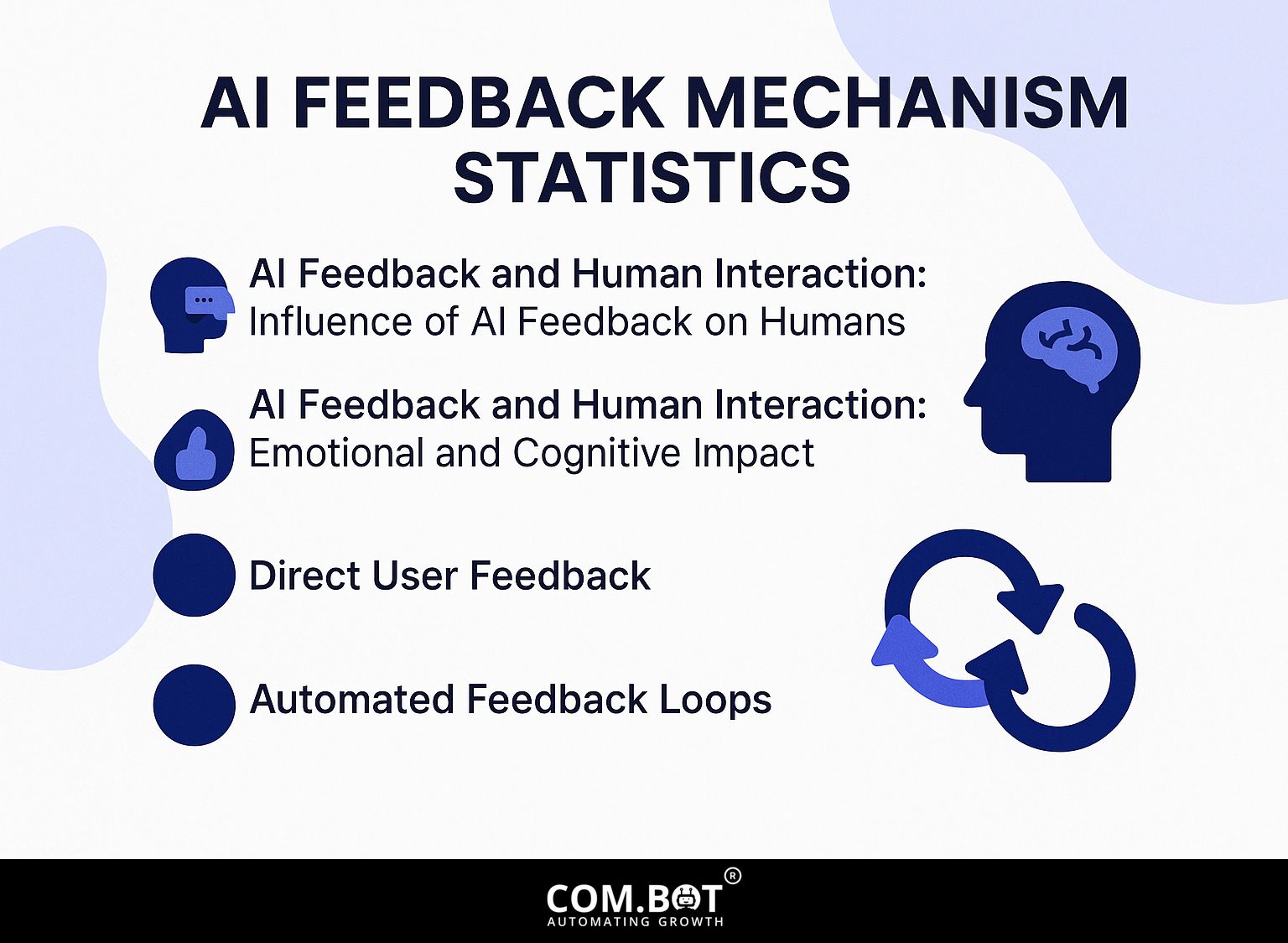
AI Feedback and Human Interaction: Influence of AI Feedback on Humans
AI Feedback and Human Interaction: Emotional and Cognitive Impact
The AI Feedback Mechanism Statistics Provide useful information on how AI feedback influences human actions and thinking, pointing out dangers and possible effects of AI communication. Grasping these patterns is important for creating AI systems that encourage good communication among people.
AI Feedback and Human Interaction data reveals significant effects on bias and representation. Bias Amplification in Human-AI Interaction stands at 65.33%, suggesting AI can exacerbate existing biases. Comparatively, the Human Baseline Bias is 53.08%, indicating that AI feedback increases bias by 6.5%. This amplification calls for careful design and ethical considerations in AI systems to mitigate bias reinforcement.
- Notably, Stable Diffusion’s White Men Representation is 85%, illustrating potential skew in AI-generated outputs. This overrepresentation highlights the need for diverse data and algorithms that promote inclusivity and avoid perpetuating stereotypes.
Emotional and Cognitive Impact looks into how AI feedback influences how people see themselves and their learning process. AI Negative Feedback Reduces Self-Efficacy by 0.12%, showing even minor negative feedback can impact self-confidence. This highlights the importance of constructive and balanced feedback systems in AI design.
- The AI Knowledge Influence effect is 16%, indicating AI can significantly impact learning and information processing. Using AI correctly can improve learning, but it needs to be managed well to avoid spreading false information or creating reliance.
These statistics highlight the complicated nature of human-AI interactions, showing the need for ethical, fair, and inclusive strategies in AI development. By recognizing and dealing with these factors, AI can be used to improve human abilities while reducing negative effects.
Direct User Feedback
Feedback from users is gathered through surveys, ratings, and reviews, allowing systems to change based on current user interactions.
To gather and analyze user feedback quickly, you can use tools like Google Forms to create surveys that suit your needs.
Once the surveys are sent out, you can gather the answers and look at them using Google Sheets to spot patterns and find ways to make things better. If several users mention they struggle with the interface, developers should concentrate on simplifying the design.
Adding a rating system to the app can give regular feedback, helping to make improvements that meet user needs.
Automated Feedback Loops
Systems that automatically analyze user interactions allow AI to modify algorithms on their own, enhancing functionality.
To create efficient systems for automatic feedback, try using Google Analytics to track how users interact and gather information.
Create your own Python scripts using libraries such as Pandas and NumPy to study interaction patterns.
Integrate monitoring dashboards such as Grafana to visualize data trends in real-time.
Companies have successfully employed these methods; for instance, Netflix uses feedback loops to recommend shows, adjusting their recommendations based on viewing habits, which increases user engagement significantly.
Techniques for Gathering Feedback
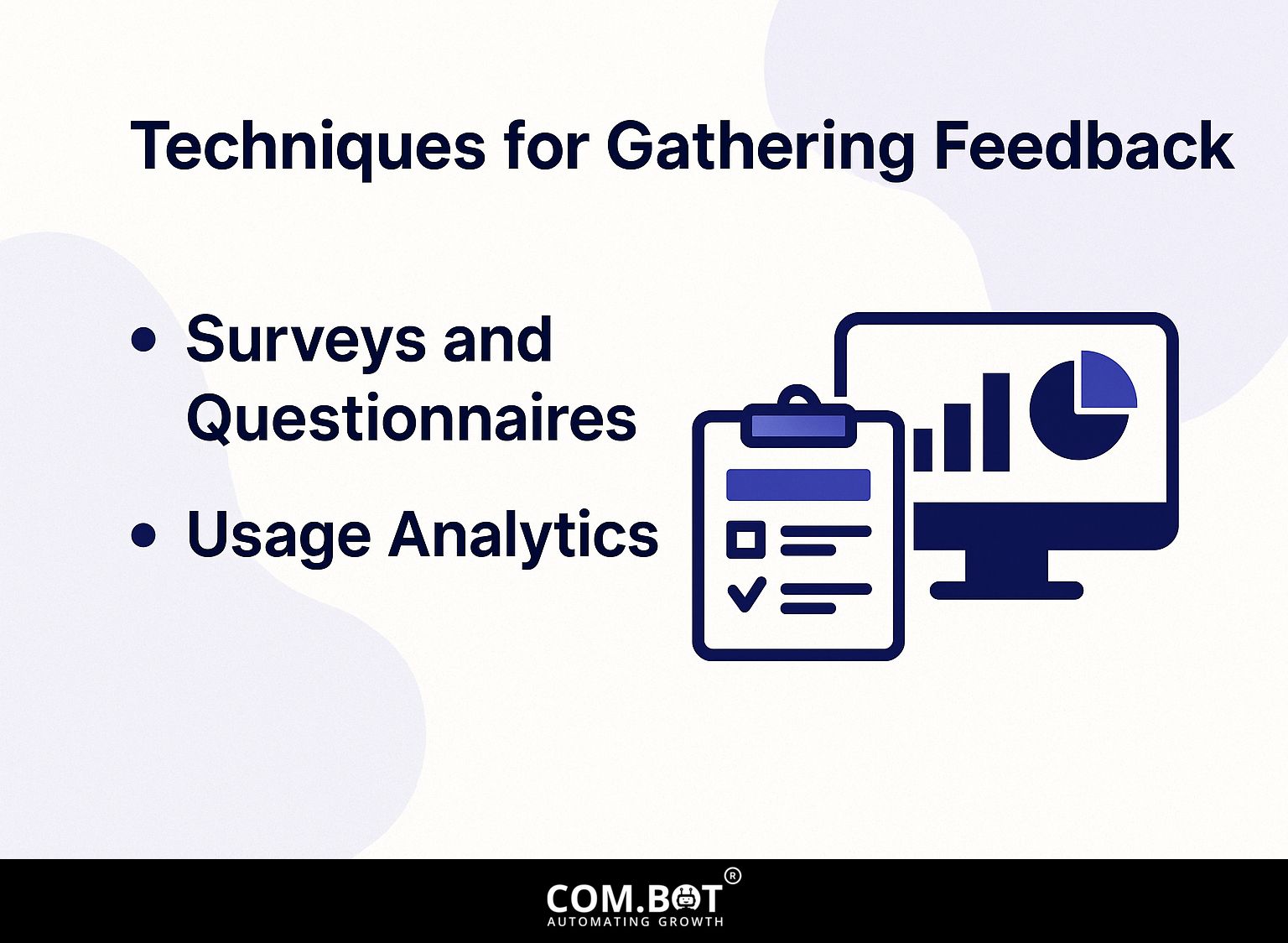
Methods for collecting feedback are important for knowing how users feel and are often done through surveys, data analysis, and direct comments from users (our detailed exploration of feedback mechanisms for AI systems discusses advanced techniques).
Surveys and Questionnaires
Surveys and questionnaires can provide useful information, with well-made surveys increasing response rates by more than 40% when using platforms like SurveyMonkey.
To create effective surveys, start by defining your goals clearly. Use concise, well-phrased questions to avoid confusion; for instance, opt for multiple-choice questions when possible, as they simplify analysis.
Use tools like Typeform to make the interface more attractive, which can motivate users to finish. Think about sending emails or posting on social media to get more replies.
Testing various survey designs using tools like Google Forms can help find out which style connects best with your audience.
Usage Analytics
Usage analytics tools like Google Analytics can track user interactions, providing critical feedback on how users engage with AI systems and identifying areas for improvement.
Monitoring certain data points is essential for knowing how users act.
Key metrics include:
- Bounce rate
- User session duration
- Conversion rate
For instance, a high bounce rate may indicate that users find content unengaging or confusing, suggesting a need for clearer information presentation. Session duration can show how engaging your AI-generated content is, and conversion rates can show how well it meets user objectives.
By regularly examining these measurements, you can improve your AI results, adjusting them to better satisfy user requirements and improve overall effectiveness.
Analyzing Feedback Data
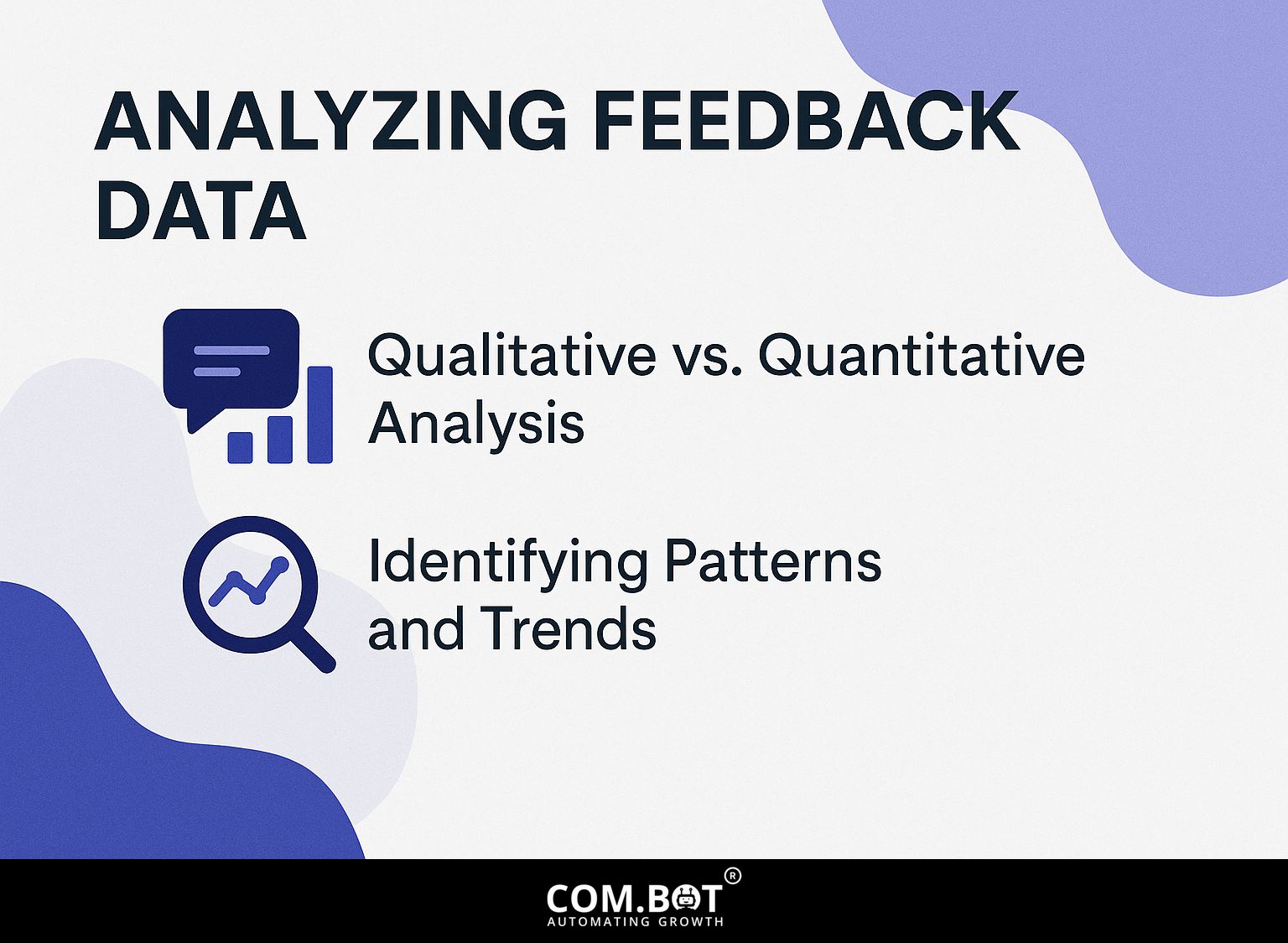
Looking at feedback data is essential for getting useful information. Knowing the difference between qualitative and quantitative analysis can help improve strategies.
Qualitative vs. Quantitative Analysis
Qualitative analysis examines user feelings through reviews, while quantitative analysis tracks performance using numbers.
Qualitative analysis uses software like NVivo to categorize and understand patterns in user feedback, giving a look into customer feelings and reasons. Conversely, quantitative analysis employs software such as Excel or Google Sheets to track metrics like sales growth or website traffic over time.
For example, using NVivo, a company might find that customers really want eco-friendly products. Meanwhile, Excel might show a 30% drop in people leaving their shopping carts without buying after the checkout process was made better. Together, these analyses offer a complete overview of consumer behavior.
Identifying Patterns and Trends
Finding patterns and trends in feedback data can show user preferences. Tools like Tableau offer strong data visualization features to share findings effectively.
- To analyze feedback effectively, start by collecting data from various sources, such as surveys, customer reviews, and social media.
- Use Tableau to create interactive dashboards, enabling you to filter and drill down into specific feedback areas.
- Consider employing sentiment analysis tools like MonkeyLearn to categorize feedback by positivity or negativity.
- Regularly review these visualizations and analyses to spot emerging trends, adjusting your strategies accordingly.
This approach helps people understand better and make more targeted decisions using user feedback.
Implementing Feedback for Improvement
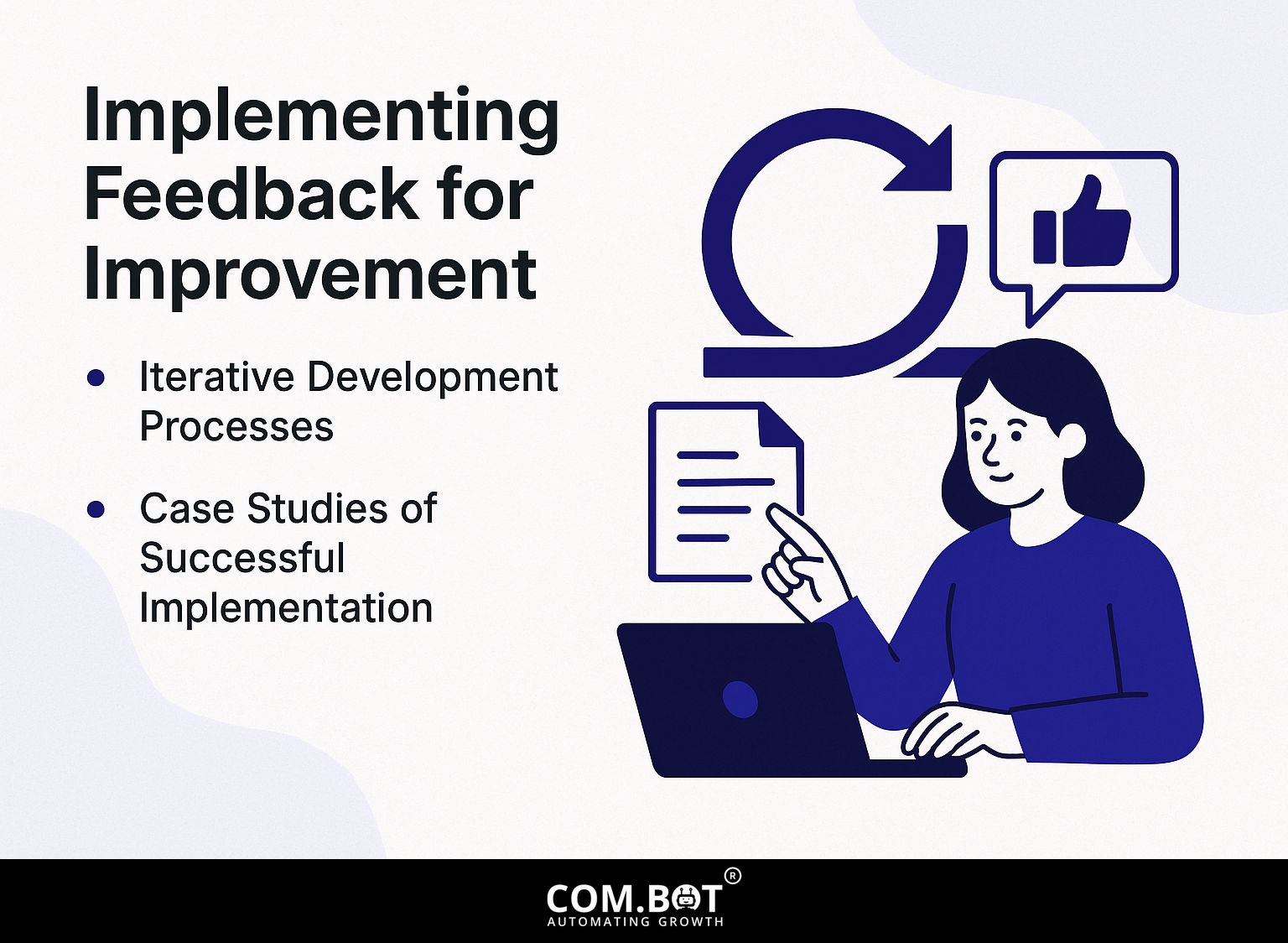
Including feedback in development is important for ongoing improvement and is often done through repeated development cycles.
Iterative Development Processes
Agile development methods use feedback loops to continually make AI systems better by considering user input, making them more adaptable.
For example, a team developing a natural language processing tool might start by releasing a minimal viable product (MVP). Users provide feedback on accuracy and ease of use, contributing to continuous improvements.
This approach was successfully applied by OpenAI in their GPT models, which evolved through multiple iterations based on user interactions and performance metrics.
In the same way, companies like Spotify use Agile methods to change their AI-based suggestion systems so they align with what users like and keep their interest. Regular updates based on real-time data help the system stay relevant and effective.
Case Studies of Successful Implementation
Various examples demonstrate effective use of feedback systems. For instance, OpenAI used input from users to make GPT-3 better.
For instance, a notable case involved an AI tool used in customer service. By analyzing user interactions, developers identified a 30% increase in response accuracy after implementing user suggestions for improved phrasing.
Another example is a recommendation engine that increased user satisfaction scores by 25% by using direct feedback from users. Regular updates using user feedback made AI systems more responsive and effective, showing how feedback helps in making ongoing improvements.
Challenges in Feedback Integration
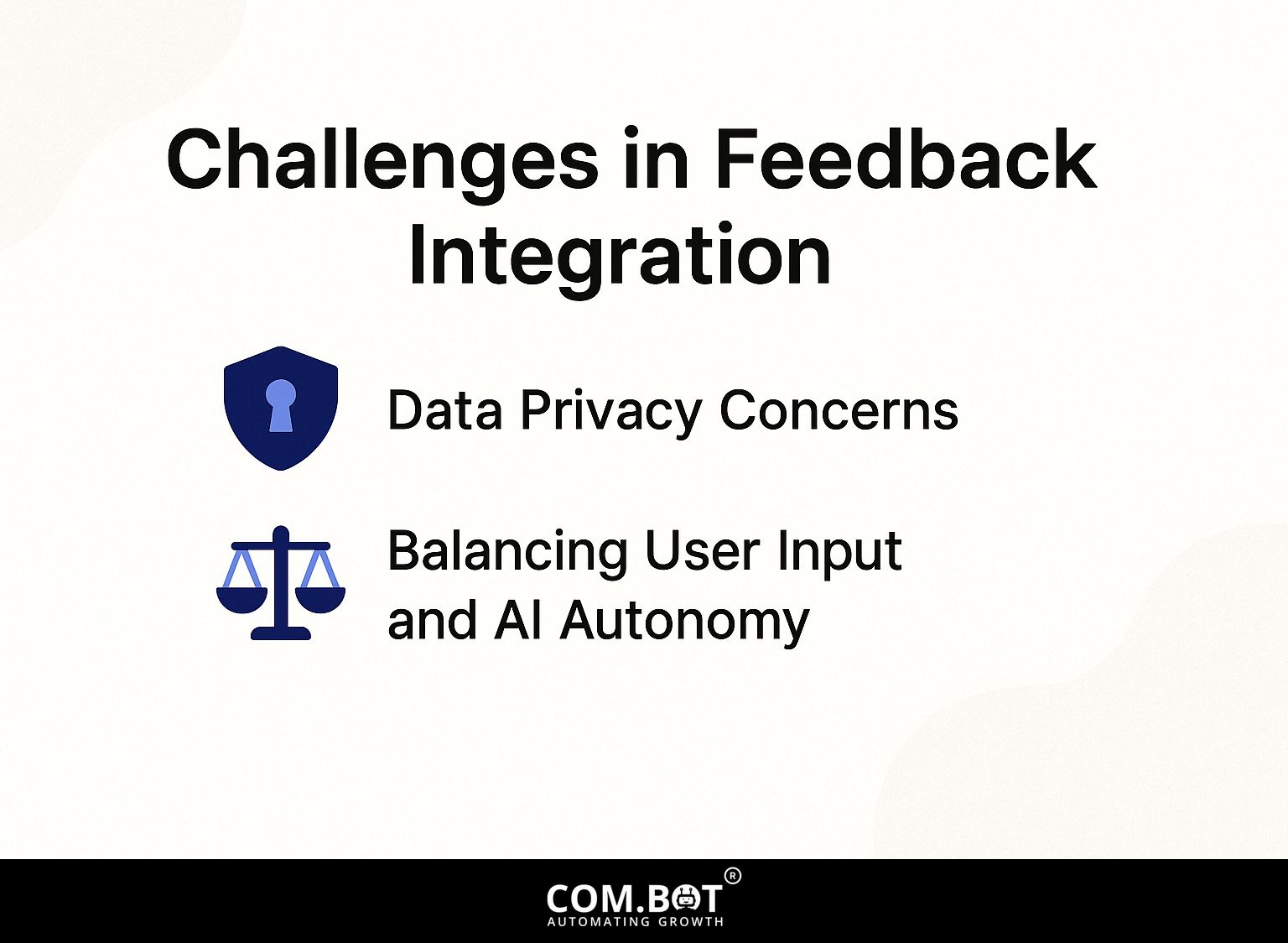
Using feedback in AI systems is challenging due to issues like protecting personal data and finding a balance between user suggestions and the independence of the AI. Worth exploring: Feedback for AI Systems: Importance and Improvement Techniques which discusses strategies to optimize feedback integration while maintaining system autonomy.
Data Privacy Concerns
Data privacy concerns are paramount, as 70% of users are wary of how their feedback is used, necessitating transparent policies to maintain trust.
To address these concerns, implement clear data handling protocols. First, inform users about what data is collected and the purpose behind it.
Write your privacy policy in clear and simple language, without using complicated terms. Allow users to opt-in for data collection, ensuring consent is both informed and voluntary.
Tools like TrustArc can help manage compliance with regulations such as GDPR. Regularly checking your processes shows you are dedicated to ethical data practices and helps build user trust in your platform.
Balancing User Input and AI Autonomy
It’s important to find the right balance between user input and AI working on its own. Depending too much on feedback can limit the system’s ability to work independently.
To achieve this balance, think about setting up a feedback system that can adjust over time. For instance, design your AI to analyze user feedback trends rather than individual comments, allowing it to discern overarching patterns without becoming overly reactive.
Systems like Google’s AutoML use feedback from users during the first training phase but work independently once in use. This method improves how decisions are made and helps the AI keep its own abilities, supporting both consistent and improved performance.
Upcoming Trends in AI Feedback Systems
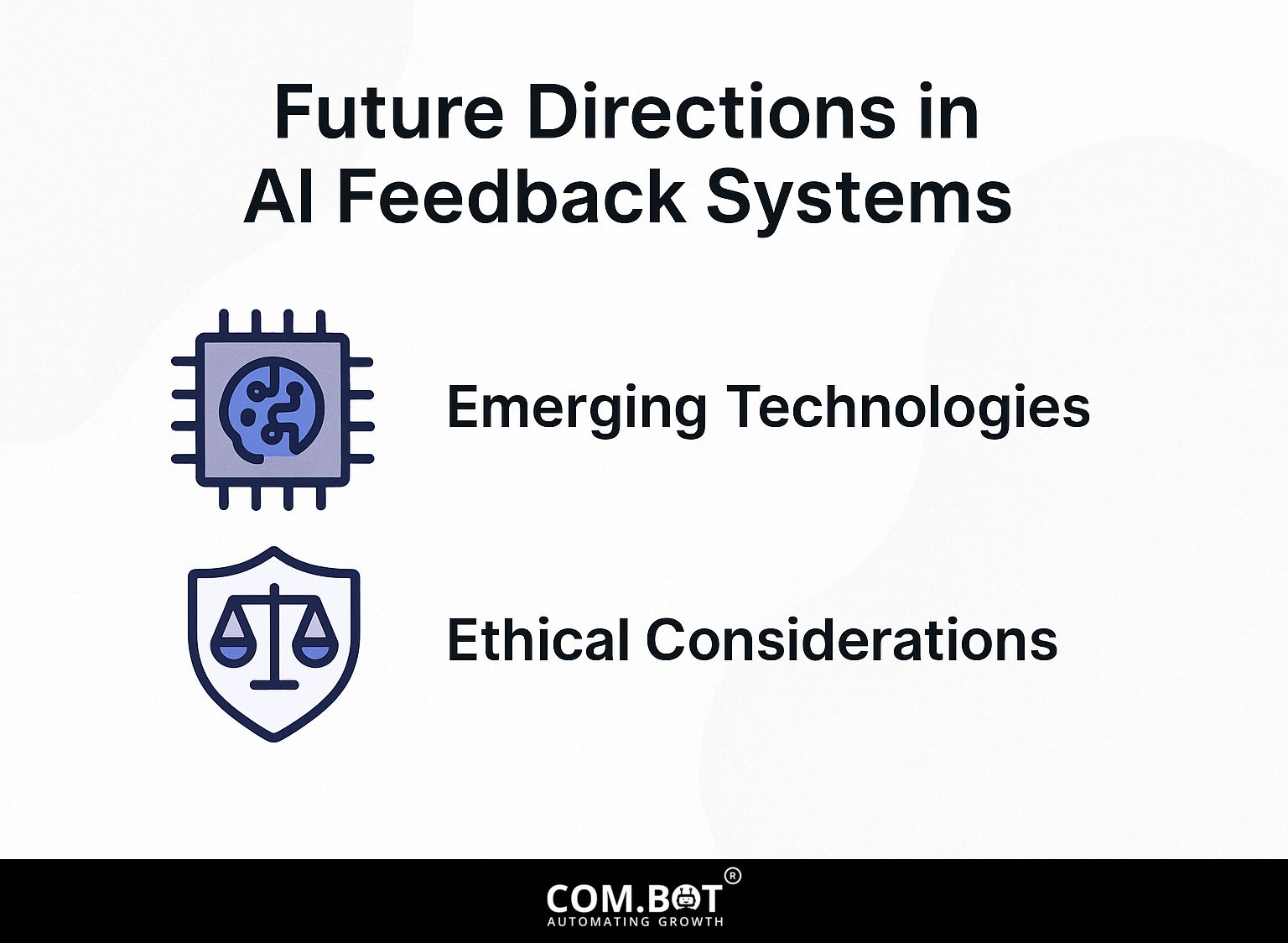
As AI grows, feedback systems change too, with new technologies providing fresh possibilities and ethical issues changing the field. Curious about how feedback mechanisms evolve in AI systems? Our detailed exploration offers insights into the importance and improvement techniques shaping the future.
Emerging Technologies
New technologies like reinforcement learning and real-time data processing are going to change how feedback is added into AI systems.
Reinforcement learning allows AI to gain experience from its surroundings, helping it make better choices as it learns.
For instance, in gaming, an AI can improve its tactics by reviewing previous actions and results. Real-time data processing lets models change right away based on what users say, which is important for things like chatbots.
Programs like TensorFlow provide solid structures for creating these technologies. Using these methods, developers can build AI systems that improve quickly, resulting in better performance and happier users.
Ethical Considerations
Ethical considerations surrounding feedback integration are critical, especially regarding bias mitigation and ensuring equitable AI systems.
To address these issues promptly, organizations should apply a range of reliable methods.
- Employ diverse data sources to train AI systems, which helps counteract inherent biases.
- Regularly review AI models to assess how they make decisions. This helps maintain transparency and accountability. Tools like Fairness Indicators or AIF360 can aid in identifying bias in predictions.
- Encourage a welcoming environment by including a variety of people involved in the development process, so that different viewpoints are taken into account during feedback.
Frequently Asked Questions
What is the importance of feedback for AI systems?
Feedback is important for AI systems because it allows them to keep learning and getting better at what they do. Without feedback, AI systems would not be able to adjust to new situations and would stay fixed in how they make decisions and solve problems.
How does feedback help in improving AI systems?
Feedback gives important details to AI systems about how they are doing, helping them find and fix mistakes or unfairness in their calculations. This leads to improved accuracy, efficiency, and overall effectiveness of the AI system.
What are some key techniques for giving feedback to AI systems?
Some effective techniques for giving feedback to AI systems include providing specific and actionable comments, using a mix of positive and negative feedback, and utilizing real-world data and scenarios for evaluation.
Why is continuous feedback important for AI systems?
Ongoing feedback helps AI systems keep getting better and handle new user needs and situations. It also allows for early detection and correction of any potential biases or errors in the system.
How can feedback help address ethical concerns in AI systems?
Feedback can help address ethical concerns in AI systems by allowing for the identification and elimination of any biased or discriminatory algorithms. It also allows for different viewpoints and feedback to be part of the AI system’s training and evaluation process.
What role do humans play in providing feedback for AI systems?
Humans are essential for giving feedback to AI systems. They can judge how well the system works in real situations and offer views that data might miss. Human feedback helps make sure that the AI system follows ethical and moral guidelines.
